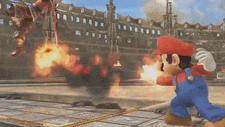| Welcome to SmashWiki! Log in or create an account and join the community, and don't forget to read this first! |
| Notices |
|---|
| The Skill parameter has been removed from Smasher infoboxes, and in its place are the new "Best historical ranking" and "Best tournament result" parameters. SmashWiki needs help adding these new parameters to Smasher infoboxes, refer to the guidelines here for what should be included in these new parameters. |
| When adding results to Smasher pages, include each tournament's entrant number in addition to the player's placement, and use the {{Trn}} template with the matching game specified. Please also fix old results on Smasher pages that do not abide to this standard. Refer to our Smasher article guidelines to see how results tables should be formatted. |
| Check out our project page for ongoing projects that SmashWiki needs help with. |
Back Slash: Difference between revisions
mNo edit summary |
(→Overview: minor reword) |
||
| Line 11: | Line 11: | ||
==Overview== | ==Overview== | ||
Shulk performs a slash attack with the Monado. The amount of [[knockback]] and damage inflicted increases if the move is used from behind the opponent. A successful attacks on an opponent's back will deal bonus damage and put them into a different knockback animation, facing away from Shulk, the same animation triggered by bouncing off a wall after suffering knockback. | |||
Shulk cannot cancel out of the move when he has initiated it: as a result, careless use of it can result in opponents punishing the attack's lag, and it can also result in a [[self-destruct]] if used too close to a ledge. In addition, despite the small lateral movement Shulk gets from initiating the move in the air, utilizing it as [[recovery]] is risky as the move does not [[edge sweet spot|sweetspot]] ledges. | |||
Shulk cannot cancel out of the move when he has initiated it | |||
It is also one of the few moves with a back-hitting hitstun animation, as the opponent does not automatically turn around when receiving a hit from this attack. | It is also one of the few moves with a back-hitting hitstun animation, as the opponent does not automatically turn around when receiving a hit from this attack. | ||
Revision as of 20:56, January 31, 2015
| Back Slash | |
|---|---|
 Shulk performing Back Slash on Mario and Dedede, demonstrating the attack's knockback discrepancy. | |
| User | Shulk |
| Universe | Xenoblade |
Back Slash (バックスラッシュ, Back Slash) is Shulk's side special move in Super Smash Bros. 4.
Overview
Shulk performs a slash attack with the Monado. The amount of knockback and damage inflicted increases if the move is used from behind the opponent. A successful attacks on an opponent's back will deal bonus damage and put them into a different knockback animation, facing away from Shulk, the same animation triggered by bouncing off a wall after suffering knockback.
Shulk cannot cancel out of the move when he has initiated it: as a result, careless use of it can result in opponents punishing the attack's lag, and it can also result in a self-destruct if used too close to a ledge. In addition, despite the small lateral movement Shulk gets from initiating the move in the air, utilizing it as recovery is risky as the move does not sweetspot ledges.
It is also one of the few moves with a back-hitting hitstun animation, as the opponent does not automatically turn around when receiving a hit from this attack.
Customization
Special Move customization was added in Super Smash Bros. 4. These are the known variations:
- Back Slash Leap: Shulk leaps up before slashing downward towards the ground. Has reduced horizontal movement, but comes out a little faster.
- Back Slash Charge: Shulk leaps forward, gaining super armor for the slash. This move has increased horizontal movement, but has harshly reduced damage if not striking the back.
Origin
Back Slash is one of Shulk's physical arts in Xenoblade Chronicles: if the move is used from behind, the enemy takes double the normal damage. Otherwise, it is treated like a normal attack. The red color of the Monado's beam is a reference to the red which identifies physical arts in the menus.

